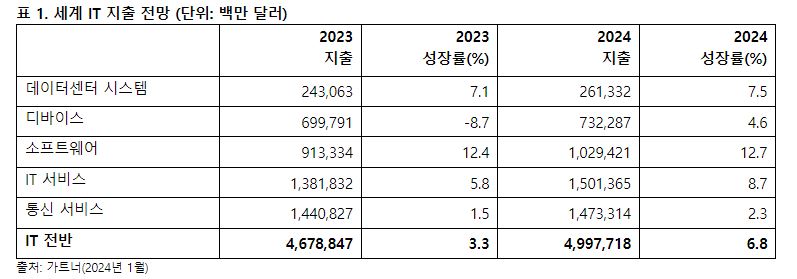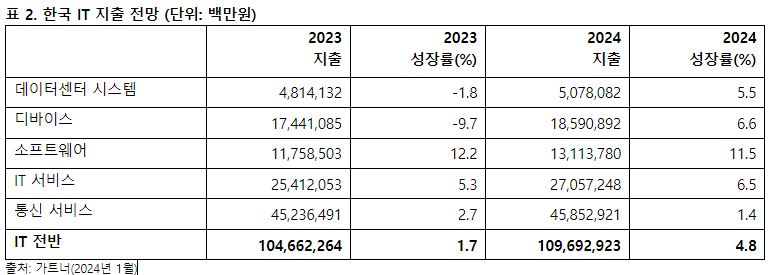“생성형 AI는 모든 것을 변화시키지만, 우리가 이미 경험한 IoT, 블록체인 및 기타 대형 트렌드와 마찬가지로 IT 지출에는 큰 영향을 미치지 못할 전망이다”

▲2024년 세계 IT 지출 전망(자료:가트너)
전세계 IT 지출 총 5조달러 6.8% 증가 전망
기대감 정점 찍은 생성형 AI 영향은 제한적
IT 서비스 지출, 첫 통신 서비스 추월 전망
“생성형 AI는 모든 것을 변화시키지만, 우리가 이미 경험한 IoT, 블록체인 및 기타 대형 트렌드와 마찬가지로 IT 지출에는 큰 영향을 미치지 못할 전망이다”
가트너의 수석 VP 애널리스트인 존 데이비드 러브록(John-David Lovelock)은 생성형 AI에 대한 기대감이 시장에 만연해 있지만 반대로 지속적인 변화에 누적된 피로감으로 인해 IT 지출 추세는 다소 제한될 것으로 예측하는 말을 남겼다.
글로벌 시장조사기관 가트너(Gartner)가 2024년 전 세계 IT 지출이 2023년보다 6.8% 증가한 총 5조 달러에 이를 것이며 이 가운데 한국의 IT 지출은 지난해와 비교해 2024년 4.8% 증가한 109조 7,000억원에 달할 것으로 예측된다는 전망을 22일 발표했다.
국내 IT 지출은 전체 부문에서 모두 성장이 예측되고 있으며 특히 소프트웨어 부문이 11.5%의 높은 성장세를 계속 이어나갈 것으로 점쳐진다. 디바이스와 IT 서비스 부문도 각각 6.6%와 6.5%의 성장률을 보일 것으로 전망된다.

▲2024년 한국 IT지출 전망(자료:가트너)
특히 가트너는 지난해 생성형 AI가 큰 기대를 받았지만 단기적인 IT 지출 성장에는 큰 변화가 없을 것으로 예측했다.
존 수석은 “2024년은 조직이 생성형 AI를 어떻게 사용할지 계획하는 데 실질적인 투자를 하는 한 해가 될 것”이라고 말하면서도, “IT 지출은 수익성, 노동력과 같이 보다 전통적인 힘에 의해 주도되는 반면, 지속적인 변화 피로의 영향으로 인해 주춤할 것"이라고 설명했다.
전세계 IT 서비스 부문은 2024년에도 성장세를 이어가며 사상 최초로 IT 지출의 가장 큰 비중을 차지할 전망이다.
올해 글로벌 IT 서비스 지출은 작년보다 8.7% 증가한 총 1조 5천억 달러에 이를 것으로 예상되며, 요인으로는 주로 기업이 조직 효율성 및 최적화 프로젝트에 투자하기 때문인 것으로 풀이된다. 이러한 투자는 현재 시점의 경제 불확실성이 큰 시기에 크게 고려되는 요인 중 하나이다.
러브록 애널리스트는 “소비자들의 디바이스 및 통신 서비스 채택률은 10여년 전부터 정체되어 있다”며, “소비자 지출 수준은 주로 가격 변화와 교체 주기에 따라 결정되기 때문에 성장이 더딜 수밖에 없어, 소프트웨어와 서비스에 추월당하는 것이 불가피하다”고 분석했다.
이어서 그는 “IT가 백오피스에서 프론트 오피스로 넘어와 수익을 창출하게 된 것처럼, 기업들은 계속해서 더 다양한 기술 사용처를 찾고 있다”며 “기업에서 기술을 어떻게, 어디에 사용할지 여부를 안정적으로 확립하기 전까지 기업 IT 지출에 정체는 없을 것”이라고 전했다.
2023년 전체 IT 지출 증가율은 3.3%로, 2022년에 대비 0.3% 증가에 그쳤다. 이는 주로 CIO들의 변화 피로 때문인 것으로 밝혀졌는데, 2024년에는 모멘텀을 회복해 전체 IT 지출이 6.8% 증가할 것으로 예상된다.
반면 2024년에도 변화 피로로 인해 전반적인 IT 지출 환경이 다소 제약을 받을 것으로 예측된다.
변화에 대한 피로면에서 CIO의 변화 저항 즉, 새로운 계약 체결이나 장기적인 이니셔티브 추진 또는 새로운 기술 파트너와의 협력을 주저하는 모습으로 나타날 수 있을 것으로 예상했다.새로운 이니셔티브를 시작하기 위해서는 CIO에게 더 높은 수준의 리스크 완화 방안이나 결과에 대한 확신이 필요한 상황이다.